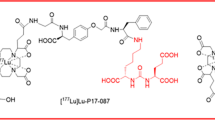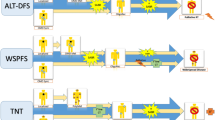Abstract
Background
Radium-223-dichloride (Ra-223) is an alpha-emitting, bone seeking radionuclide therapy approved for patients with metastatic castration-resistant prostate cancer (mCRPC). In the fall of 2014, a global temporary shortage of Ra-223 occurred for 2 months due to production irregularities. The aim of this study was to assess whether prolonged interval between Ra-223 cycles to non-disease related causes had a negative impact on clinical outcome of therapy.
Materials and methods
Retrospective single-center study of mCRPC patients who initiated Ra-223 therapy in the period from March 2014 to February 2015. End points were number of completed Ra-223 cycles, overall survival (OS) and radiographic progression-free survival (rPFS). Bone scintigraphy, CT of thorax and abdomen, hematological status, PSA and alkaline phosphatase were evaluated prior to first dose and after 3rd and 6th treatment, respectively. Follow-up period was 18 months after first Ra-223 cycle.
Results
A total of 50 consecutive patients initiated Ra-223 therapy in the time period. Seventeen of 50 patients (34%) had prolonged interval between cycles due to delivery problems. Median delay was 4 weeks (range 3–9 weeks). Patients with delayed treatment had significantly longer median rPFS [delayed patients: 7.1 months (95% CI 4.9–9.3) vs. 4.5 months (95% CI 2.8–6.3)]. There was no significant difference in number of completed cycles or median OS.
Conclusion
We find no negative impact of prolonged interval between Ra-223 cycles due to non-disease related reasons on OS, rPFS or number of completed treatment cycles.


Similar content being viewed by others
References
Henriksen G, Breistøl K, Bruland ØS, Fodstad Ø, Larsen RH. Significant antitumor effect from bone-seeking, α-particle-emitting 223Ra demonstrated in an experimental skeletal metastases model. Cancer Res. 2002;62:3120–5.
Parker C, Nilsson S, Heinrich D, Helle SI, O’Sullivan JM, Fosså SD, et al. Alpha emitter radium-223 and survival in metastatic prostate cancer. N Engl J Med. 2013;369:213–23.
Sartor O, Coleman R, Nilsson S, Heinrich D, Helle SI, O’Sullivan JM, et al. Effect of radium-223 dichloride on symptomatic skeletal events in patients with castration-resistant prostate cancer and bone metastases: results from a phase 3, double-blind, randomised trial. Lancet Oncol. 2014;15:738–46.
European Medicines Agency. Xofigo (radium-223 dichloride) Supply shortage; (EMA notice) London, 2015. http://www.ema.europa.eu/docs/en_GB/document_library/Supply_shortage/2014/10/WC500175796.pdf. Accessed 25 Jan 2017.
Sonpavde G, Pond GR, Armstrong AJ, Galsky MD, Leopold L, Wood BA, et al. Radiographic progression by Prostate Cancer Working Group (PCWG)-2 criteria as an intermediate endpoint for drug development in metastatic castration-resistant prostate cancer. BJU Int. 2014;114:E25-31.
Wahl RL, Jacene H, Kasamon Y, Lodge MA. From RECIST to PERCIST: evolving considerations for PET response criteria in solid tumors. J Nucl Med. 2009;50(Suppl 1):122S–150S.
Etchebehere EC, Milton DR, Araujo JC, Swanston NM, Macapinlac HA, Rohren EM. Factors affecting 223Ra therapy: clinical experience after 532 cycles from a single institution. Eur J Nucl Med Mol Imaging. 2016;43:8–20.
Alva A, Nordquist L, Daignault S, George S, Ramos J, Albany C, et al. Clinical correlates of benefit from radium-223 therapy in metastatic castration resistant prostate cancer. Prostate. 2016. doi:10.1002/pros.23286 (e-pub ahead of print., Dec 19).
Saad F, Carles J, Gillessen S, Heidenreich A, Heinrich D, Gratt J, et al. Radium-223 and concomitant therapies in patients with metastatic castration-resistant prostate cancer: an international, early access, open-label, single-arm phase 3b trial. Lancet Oncol. 2016;17:1306–16.
Jadvar H, Challa S, Quinn DI, Conti PS. One-year postapproval clinical experience with radium-223 dichloride in patients with metastatic castrate-resistant prostate cancer. Cancer Biother Radiopharm. 2015;30:195–9.
Nome R, Hernes E, Bogsrud TV, Bjøro T, Fosså SD. Changes in prostate-specific antigen, markers of bone metabolism and bone scans after treatment with radium-223. Scand J Urol. 2015;49:211–7.
Keizman D, Fosboel MO, Reichegger H, Peer A, Rosenbaum E, Desax M-C, et al. Imaging response during therapy with radium-223 for castration-resistant prostate cancer with bone metastases—analysis of an international multicenter database. Prostate Cancer Prostatic Dis. 2017. doi:10.1038/pcan.2017.6 (e-pub ahead of print 28 February 2017).
Carrasquillo J a., O’Donoghue J a., Pandit-Taskar N, Humm JL, Rathkopf DE, Slovin SF, et al. Phase i pharmacokinetic and biodistribution study with escalating doses of 223Ra-dichloride in men with castration-resistant metastatic prostate cancer. Eur J Nucl Med Mol Imaging. 2013;40:1384–93.
Chittenden SJ, Hindorf C, Parker CC, Lewington VJ, Pratt BE, Johnson B, et al. A Phase 1, open-label study of the biodistribution, pharmacokinetics and dosimetry of Radium-223 dichloride (223Ra dichloride) in patients with hormone refractory prostate cancer and skeletal metastases. J Nucl Med 2015; 56;1304–9.
Parker CC, Pascoe S, Chodacki A, O’Sullivan JM, Germá JR, O’Bryan-Tear CG, et al. A randomized, double-blind, dose-finding, multicenter, phase 2 study of radium chloride (Ra 223) in patients with bone metastases and castration-resistant prostate cancer. Eur Urol. 2013;63:189–97.
Nilsson S, Larsen RH, Fosså SD, Balteskard L, Borch KW, Westlin J-E, et al. First clinical experience with alpha-emitting radium-223 in the treatment of skeletal metastases. Clin Cancer Res. 2005;11:4451–9.
Abou DS, Ulmert D, Doucet M, Hobbs RF, Riddle RC, Thorek DLJ. Whole-body and microenvironmental localization of radium-223 in naïve and mouse models of prostate cancer metastasis. J Natl Cancer Inst. 2016;108:5.
Hobbs R, Ramdahl T, Flux GD, Sgouros G. A bone marrow toxicity model for 223Ra alpha-emitter radiopharmaceutical therapy. Phys Med Biol. 2013;57:3207–22.
Gholami Y, Zhu X, Fulton R, Meikle S, El-Fakhri G, Kuncic Z. Stochastic simulation of radium-223 dichloride therapy at the sub-cellular level. Phys Med Biol. 2015;60:6087–96.
Blyth BJ, Sykes PJ. Radiation-induced bystander effects: what are they, and how relevant are they to human radiation exposures? Radiat Res. 2011;176:139–57.
Boyd M, Ross SC, Dorrens J, Fullerton NE, Tan KW, Zalutsky MR, et al. Radiation-induced biologic bystander effect elicited in vitro by targeted radiopharmaceuticals labeled with alpha-, beta-, and auger electron-emitting radionuclides. J Nucl Med. 2006;47:1007–15.
Li X, Koh AJ, Wang Z, Soki FN, Park SI, Pienta KJ, et al. Inhibitory effects of megakaryocytic cells in prostate cancer skeletal metastasis. J Bone Miner Res. 2011;26:125–34.
Monzen S, Takahashi K, Yoshino H, Kasai-Eguchi K, Abe Y, Maruyama A, et al. Heavy ion beam irradiation regulates the mRNA expression in megakaryocytopoiesis from human hematopoietic stem/progenitor cells. J Radiat Res. 2009;50:477–86.
Monzen S, Osuda K, Miyazaki Y, Hayashi N, Takahashi K, Kashiwakura I. Radiation sensitivities in the terminal stages of megakaryocytic maturation and platelet production. Radiat Res. 2009;172:314–20.
Vogelzang NJ, Coleman RE, Michalski JM, Nilsson S, O’Sullivan JM, Parker C, et al. Hematologic safety of radium-223 dichloride: baseline prognostic factors associated with myelosuppression in the ALSYMPCA trial. Clin Genitourin Cancer. 2017;15:42–5.
Author information
Authors and Affiliations
Corresponding author
Ethics declarations
Conflict of interest
PMP: Advisory Board Member, Bayer Healthcare. The remaining authors report no conflicts of interest.
Rights and permissions
About this article
Cite this article
Fosbøl, M.Ø., Petersen, P.M., Daugaard, G. et al. Impact of treatment delay in Radium-223 therapy of metastatic castration-resistant prostate cancer patients. Ann Nucl Med 32, 16–21 (2018). https://doi.org/10.1007/s12149-017-1212-1
Received:
Accepted:
Published:
Issue Date:
DOI: https://doi.org/10.1007/s12149-017-1212-1




